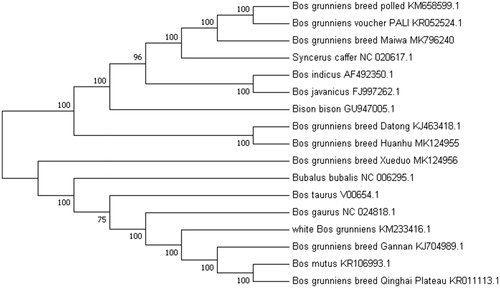Abstract
Maiwa yak is a unique local strain of yak breed resource in China. The complete mitochondrial genome was identified in this work. The mitochondrial DNA is a circular molecule with 16,324 bp in length, including 13 protein-coding genes, 2 rRNA genes, 22 tRNA genes, and a non-coding control region(D-loop). The overall nucleotide ratio is A (33.70%), G (13.22%), T (27.26%), C (25.82%) with a C + G content of 39.04%. Phylogenetic analysis of mitochondrial genomes of 17 close species using MEGA7.0 showed that Maiwa yak is most related to Pali yak and polled yak.
Yak is a unique economic animal in the plateau, which provides meat, fur, milk, and other products for local aborigines. It has good adaptability to the plateau environment and diseases resistance. Maiwa yak is mainly distributed in Aba Prefecture, Sichuan Province, which is located at the boundary of the Qinghai-Tibet Plateau of China. It is a significant yak genetic resource. However, fewer mitochondrial information about Maiwa yak could be used to compare its genetic evolution relationship with other yak breeds. The whole mitochondrial genome sequence of Maiwa yak was assembled and characterized in this study.
In this work, the specimens were collected from Aba Prefecture, Sichuan Province, China (N32°18′, E102°28′). Blood samples were frozen at –20 °C and stored in the Key Laboratory of Yak Breeding Engineering of Gansu Province. Total genomic DNA was extracted from the blood samples using EasyPure Blood Genomic DNA Kit (Transgen Biotch, Beijing, China) with reference to the manufacturer’s instructions. The whole mitochondrial genome was amplified with six pairs of primers using polymerase chain reaction method, and the sequencing results were assembled using DNASTAR5.0 software (Madison, WI, USA). The complete mitochondrial genomic sequence was submitted to GenBank and deposited with an accession number MK796240.
The whole mitochondrial genome is a circular DNA molecule of 16,324 bp, consisting of a non-coding control region (D-loop), 22 tRNA genes, 13 protein-coding genes (ND1-6, ND4L, COX1-3, CYTB, ATP6 and ATP8), and 2 rRNA subunits genes (12s and 16s ribosomal RNA). Compared with other yak subspecies and Bovidae, the arrangement of these genes is conservative. Three overlaps are found between protein-coding genes in the strand: ND4 overlaps with ND4L for 7bp, and ATP6 overlaps with COX3 for 1bp. Overlapping region of ATPase present in most vertebrates are common. For the basic nucleotide component statistics, the ratio of G + C was 39.04% (33.70% for A, 13.22% for G, 27.26% for T, 25.82% for C).
We constructed a phylogenetic tree containing 17 bovine mitochondrial genomes using MEGA 7.0 software with the neighbor-joining (NJ) method of 1000 bootstrap replicates to validate the location of the evolution of Maiwa yak. The result shows that 17 species are clustered into two branches, and Maiwa yak is closer to Pali yak and polled yak in the genetic relationship (). The sequence and analyses we provide in this study will contribute to the management of yak breeds, analysis of the genetic evolution of bovines, and protection of genetic resources.
Disclosure statement
No potential conflict of interest was reported by the authors.

